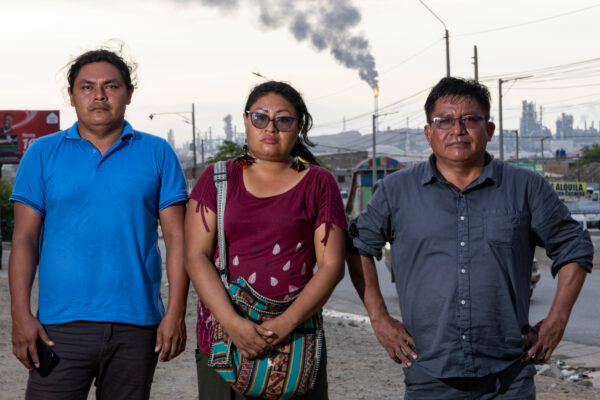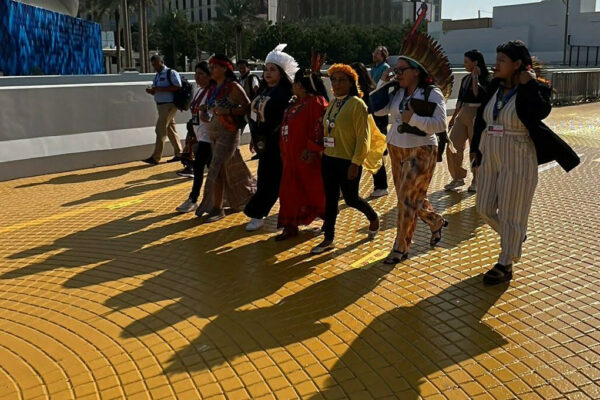The following joint letter was sent to the IDB on July 30th by international NGOs as a response to the IDB’s public posting of Camisea loan conditions fulfillment. The letter details concerns raised by leading Peruvian indigenous and environmental organizations about the Camisea gas project and urges for the loan closure to be delayed.
Mr. Enrique Iglesias
President
Inter-American Development Bank
1300 New York Avenue, NW
Washington, D.C. 20577
Dear President Iglesias,
We are writing to urge the Inter-American Development Bank to delay financial closure on its loan to the Camisea gas project in Peru. IDB Management has recently released a report to the Bank’s Board of Executive Directors concluding that the environmental, social and other conditions established for financial closure of the loan agreement have been satisfied. Based on an analysis of this and accompanying reports and observations from Peru, we disagree with the IDB’s conclusion and believe that an independently overseen multi-stakeholder process with a view to an action plan for compliance must be completed prior to financial closure.
Both Peruvian civil society and U.S. organizations that have followed the Camisea project closely have been disappointed by the views presented in the report. We believe that the IDB cannot proceed to financial closure at this time, given significant issues raised in Peru regarding potential noncompliance with the loan conditions. We concur with the sentiments expressed in a letter recently sent to you from Peruvian civil society groups that outlines many points of non-compliance and discrepancies between the original and subsequent wording on loan conditions.
We also wish to draw your attention to a few specific examples of non-compliance and problems with the loan process. These cases are:
1. Use of non-native species in revegetation
The loan conditions call for a plan to ensure adequate revegetation using appropriate native species and avoiding exotic and invasive species (8.12.i) and for evidence that all upstream areas are being effectively re-vegetated with species native to the location (Update Annex A, 3). This is critical for such important natural habitats, which include some of the most pristine and biodiverse rainforests on the planet. However, field observations by specialists have found the use of non-native species such as Brachiaria, Vetiveria, and kudzu. The consortia’s March 2004 Revegetation Status Report details the sowing of Brachiaria and kudzu at drilling platforms (this is not only contrary to the IDB condition but also to the Environmental Impact Assessment which states that native plants existing in the area will be selected for revegetation purposes in order to prevent new species from displacing local ones). In at least one upstream location, kudzu is said to have begun invading the jungle. And the Right-of-Way threatens to become a conduit for the spread of this invasive species.
2. Lack of adequate environmental assessment for locating project facilities at Paracas
The selection of Paracas Bay as the site for the coastal fractionation plant and export loading facility of the project was highly controversial due to the importance and sensitivity of this marine reserve. The conditions (Update Annex A, 14; Update 5(e)) call for a full baseline reconnaissance, further impact assessment, a revised Environmental and Social Management Plan (ESMP), and environmental monitoring plans for project activity near Paracas. This full baseline reconnaissance and further impact assessment never took place, and, instead, the documents that formed part of the original Environmental Impact Assessment (EIA) have simply been re-packaged, without providing additional information. Meanwhile, we do not detect any significant changes or improvements in the “revised” ESMP and environmental monitoring plans. The environmental monitoring plans look exactly the same as when they where first posted last year. Furthermore, the plan for the transition and operational phases are exactly the same, only slowly reducing monitoring points and sampling frequencies, and adding extra seal and bird studies that bear no relevance whatever to the impacts the project may have on the area. If the heavy tanker traffic has an impact in the area, the least likely species to be affected by this traffic are the pelagic feeding species such as seals and birds.
3. Lack of erosion control and slope stabilization
As recently as June of this month, observers in the Lower Urubamba region witnessed numerous examples of slopes along the pipeline right of way (ROW) where the ground atop or beside the buried pipeline was bare or sparsely vegetated. In some cases erosion was severe enough that landslides exposed large sections of steep slopes. These observations were in sharp contrast to IDB and Consortium monitoring reports indicating that erosion control and slope stabilization was satisfactory. It is hard to tell if these differences are due to observations in different places or a broad definition of “satisfactory,” but recent photos of seriously exposed sites taken by representatives of Amazon Watch and US AID along the pipeline route indicate that compliance has not been achieved in this critical task.
4. Lack of legal and policy changes to conform to standards of the International Finance Corporation
The original loan conditions required policy and legal changes ensuring that all future hydrocarbon concessions with output flowing through the Camisea pipeline will conform to internationally recognized environmental and social safeguards and standards, such as those of the International Finance Corporation (IFC). However, subsequent contracts have been negotiated referencing only voluntary programs and principles that do not represent internationally recognized standards such as the IFC’s.
5. Impact of project on indigenous peoples
Visits by observers to the indigenous communities in the Lower Urubamba River area have received repeated reports that fishing and game resources have continued to deteriorate at least in part due to project impacts. The loss of these primary food resources has become so marked in some areas that many people are suffering from malnutrition. The level of gastro-intestinal and venereal diseases in the communities also appears to have risen significantly in the past few years as the project has contaminated rivers and increased contacts between indigenous communities and outside society. These observations are a stark contrast to reports provided by IDB and Consortia monitors that indicate biological resources are robust, drinking water quality is high, and medical needs of affected communities are being diligently attended to. There is clearly a need to investigate this situation.
6. Involuntary resettlement
There have been several cases where the project has effectively forced peasant and indigenous communities to leave their homes and traditional land. The most egregious example concerns the way that gas exploration personnel have excluded indigenous people living in voluntary isolation from large parts of their traditional territory in the Kugapakori-Nahua reserve. Construction of the pipeline has also forced families in the communities of Huayllahura, Huancano, and Nueva Esperanza to move against their wishes without adequate consideration for their rights or compensation for their disturbance.
7. Discrepancies between original loan conditions and recent IDB report
We wish to note that there are some disturbing discrepancies between the language of the original conditions and the language of the conditions in the new IDB report summarizing compliance. One condition (8.18(v)) includes a Government of Peru commitment to “Ensure a thorough and complete review of the proposed fractionation plant and marine terminal, including as appropriate civil society input” (such a review has not happened); but the text of the condition in the new IDB report now reads, “Ensure a thorough and complete disclosure of the environmental studies on the fractionation plant and marine terminal.” Another condition (Update 5[c]) requires evidence of the Government’s assuming responsibility for the community-monitoring program (something which also has not happened); but this text disappears in the new IDB report. Peruvian civil society groups have cited other examples where the original loan conditions written in English have been translated into a Spanish version that is much weaker.
8. Need for greater transparency on monitoring reports
Part of the difficulty of evaluating the performance of the companies on the ground with the loan conditions is that the monitoring reports that are available from the IDB and Consortium are summaries that are posted many months after the events have taken place. While URS, the IDB’s monitor, submits daily, weekly, and monthly reports to the Bank, the IDB only posts the monthly summary of its findings on the website several months after the observations. While these summary reports contain extensive details of project progress, they provide only a cursory summary of project problems. From September 2002 until March 2003, these reports provided no detailed or quantitative information on project deficiencies. From April 2003 through March 2004, these reports listed a total of some 1177 deficiencies in the areas of spill prevention and secondary containment, Best Management Practices (focus on erosion control measures), health and safety management, waste management and sanitary practices, and clean up/restoration and slope stabilization (including revegetation activities). No details were provided on where these incidents occurred or what steps if any were taken by the parties concerned to address the recommendations. While the head of the IDB’s Environment and Social Unit in the Private Sector Department, Robert Montgomery, has offered to respond to specific questions about the URS monthly reports, NGO requests for access to the daily and weekly reports that we believe are essential to gaining a full understanding of the project’s performance and impacts have so far been denied. Since maintaining an open flow of information is one essential element in transparent good governance and the release of assessments and monitoring reports is a specific condition of the IDB loan for Camisea, we ask you to permit public access to all URS and other bank consultant inspection reports.
Given the outstanding concerns about noncompliance with the IDB loan conditions there is an urgent need for an independently overseen multi-stakeholder process to develop an action plan for compliance, prior to finalizing IDB financial support. Peruvian NGOs and we have expressed the need for such an audit in meetings with IDB Vice-President Dennis Flannery and Mr. Robert Montgomery in Lima and a letter to Mr. Flannery on April 26 and thus far received no response to this proposal. This audit is still needed to provide authoritative, credible, and independent guidance on the status of compliance with the IDB’s environmental and social loan conditions. Such an audit would be fundamental to evaluating the environmental and social impacts of the project to date and instrumental in designing an independent and credible monitoring system for the next phases of this and future related projects (e.g. exploration in adjoining blocks).
Given your and Mr. Flannery’s frequent assertions that every loan condition on Camisea must be fulfilled before the project receives IDB support, we strongly urge you and the IDB’s Executive Directors to ensure that the project does not proceed to financial closure at this time. We stand ready to work with the IDB and member governments to develop a plan of action and a way forward. We respectfully request to meet with you to discuss these goals in addition to the IDB’s overall systems and policies regarding environmental management and compliance. The timing for such a discussion is critical since the Bank is now revising its 25 year-old environmental policy, formulating a new indigenous peoples’ policy, and simultaneously moving to support new major infrastructure initiatives that will involve many more highly controversial infrastructure projects like Camisea.
Sincerely,
Campbell Plowden, Amazon Watch, campbell@amazonwatch.org
Peter Kostishak, Amazon Alliance, peter@amazonalliance.org
Aaron Goldzimer, Environmental Defense, agoldzimer@environmentaldefense.org
Jon Sohn, Friends of the Earth, jsohn@foe.org
Nadia Martinez, Institute for Policy Studies, nmartinez@seen.org
Cc:
Mr. Dennis Flannery, IDB, Executive Vice-President, flannery@iadb.org
Mr. Hiroshi Toyoda, IDB, Private Sector Department, hiroshito@iadb.org
Mr. Robert Montgomery, IDB, Private Sector Dept., Environment and Social Unit, robertm@iadb.org
Ms. Janine Ferretti, IDB, Sustainable Development Department, janinef@iadb.org
Mr. Jose Ignacio Estevez, IDB, Office of the Ombudsman, ignacioe@iadb.org
IDB Executive and Alternate Executive Directors













